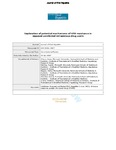Exploration of potential mechanisms of HCV resistance in exposed uninfected intravenous drug users
| dc.contributor.author | Shawa, IT | |
| dc.contributor.author | Felmlee, Daniel | |
| dc.contributor.author | Hegazy, D | |
| dc.contributor.author | Sheridan, David | |
| dc.contributor.author | Cramp, Matthew | |
| dc.date.accessioned | 2017-06-29T15:46:29Z | |
| dc.date.issued | 2017-05-30 | |
| dc.identifier.issn | 1352-0504 | |
| dc.identifier.issn | 1365-2893 | |
| dc.identifier.uri | http://hdl.handle.net/10026.1/9568 | |
| dc.description.abstract |
A rare outcome following exposure to hepatitis C virus (HCV) is a lack of observable infection as clinically measured by HCV RNA- or HCV-recognizing antibodies. The population who exhibit this trait is termed exposed uninfected (EU). Increasing evidence has refined characterization of these individuals, distinct from those who become infected but spontaneously clear HCV. Study of the EU population is highly pertinent for the discovery of antiviral mechanisms of resistance that can reveal antiviral therapeutic strategies. This review provides an overview of similarities and differences of the EU population relative to spontaneous resolvers and the majority whom develop chronic HCV infection, and focusses on possible mechanisms of resistance including innate and adaptive immunity, genetics and lipid interactions. | |
| dc.format.extent | 1082-1088 | |
| dc.format.medium | Print-Electronic | |
| dc.language | en | |
| dc.language.iso | en | |
| dc.publisher | Wiley | |
| dc.subject | cytokines | |
| dc.subject | exposed uninfected | |
| dc.subject | hepatitis C virus | |
| dc.subject | immune response | |
| dc.subject | liver | |
| dc.subject | people who inject drugs | |
| dc.subject | resistance | |
| dc.title | Exploration of potential mechanisms of HCV resistance in exposed uninfected intravenous drug users | |
| dc.type | journal-article | |
| dc.type | Journal Article | |
| dc.type | Review | |
| plymouth.author-url | https://www.webofscience.com/api/gateway?GWVersion=2&SrcApp=PARTNER_APP&SrcAuth=LinksAMR&KeyUT=WOS:000416320500001&DestLinkType=FullRecord&DestApp=ALL_WOS&UsrCustomerID=11bb513d99f797142bcfeffcc58ea008 | |
| plymouth.issue | 12 | |
| plymouth.volume | 24 | |
| plymouth.publication-status | Published online | |
| plymouth.journal | Journal of Viral Hepatitis | |
| dc.identifier.doi | 10.1111/jvh.12720 | |
| plymouth.organisational-group | /Plymouth | |
| plymouth.organisational-group | /Plymouth/Faculty of Health | |
| plymouth.organisational-group | /Plymouth/Faculty of Health/Peninsula Medical School | |
| plymouth.organisational-group | /Plymouth/REF 2021 Researchers by UoA | |
| plymouth.organisational-group | /Plymouth/REF 2021 Researchers by UoA/UoA01 Clinical Medicine | |
| plymouth.organisational-group | /Plymouth/Research Groups | |
| plymouth.organisational-group | /Plymouth/Research Groups/Institute of Translational and Stratified Medicine (ITSMED) | |
| plymouth.organisational-group | /Plymouth/Research Groups/Institute of Translational and Stratified Medicine (ITSMED)/CBR | |
| plymouth.organisational-group | /Plymouth/Users by role | |
| plymouth.organisational-group | /Plymouth/Users by role/Academics | |
| dc.publisher.place | England | |
| dcterms.dateAccepted | 2017-03-27 | |
| dc.rights.embargodate | 2018-5-30 | |
| dc.identifier.eissn | 1365-2893 | |
| dc.rights.embargoperiod | Not known | |
| rioxxterms.versionofrecord | 10.1111/jvh.12720 | |
| rioxxterms.licenseref.uri | http://www.rioxx.net/licenses/all-rights-reserved | |
| rioxxterms.licenseref.startdate | 2017-05-30 | |
| rioxxterms.type | Journal Article/Review |


